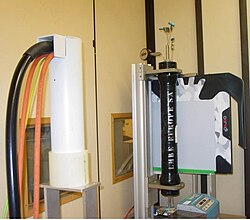Flat-panel detector

Flat-panel detectors are a class of
Principles

Indirect detectors
Indirect detectors contain a layer of
Direct FPDs
Direct conversion imagers utilize
By eliminating the optical conversion step inherent to indirect conversion detectors, lateral spread of optical photons is eliminated, thus reducing blur in the resulting signal profile in direct conversion detectors. Coupled with the small pixel sizes achievable with TFT technology, a-Se direct conversion detectors can thus provide high spatial resolution. This high spatial resolution, coupled with a-Se's relative high quantum detection efficiency for low energy photons (< 30 keV), motivate the use of this detector configuration for mammography, in which high resolution is desirable to identify microcalcifications.[6]
Advantages and disadvantages

Flat-panel detectors are more sensitive and faster than
In general radiography, there are time and cost savings to be made over computed radiography and (especially) film systems.[9][10] In the United States, digital radiography is on course to surpass use of computed radiography and film.[11][12]
In mammography, direct conversion FPDs have been shown to outperform film and indirect technologies in terms of resolution[citation needed], signal-to-noise ratio, and quantum efficiency.[13] Digital mammography is commonly recommended as the minimum standard for breast screening programmes.[14][15]
See also
- X-ray detectors
References
- .
- S2CID 16677678.
- ^ Direct vs. Indirect Conversion Archived January 2, 2010, at the Wayback Machine
- PMID 9434965.
- .
- ^ M.J. Yaffe, “Detectors for Digital Mammography,” in Digital Mammography, edited by U. Bick and F. Diekmann (2010).
- PMID 16862412.
- PMID 21415199.
- PMID 12532253.
- ^ "CR versus DR -- what are the options?". AuntMinnie.com. 31 July 2003. Retrieved 23 July 2017.
- ^ "Medicare to cut analog x-ray payments starting in 2017". AuntMinnie.com. 7 February 2016. Retrieved 23 July 2017.
- ^ "Digital Radiology: Global Transition of the X-ray Image Capture Process". Imaging Technology News. 8 February 2013. Retrieved 23 July 2017.
- ISBN 9781439875469.
- ^ NHS Breast Screening Programme (2016). Clinical guidelines for breast cancer screening assessment (4 ed.). Public Health England.
- S2CID 31652981.
